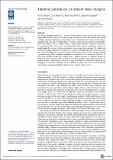| dc.contributor.author | Hunter, Pierce | |
| dc.contributor.author | Meyer, Colin | |
| dc.contributor.author | Minchew, Brent | |
| dc.contributor.author | Haseloff, Marianne | |
| dc.contributor.author | Rempel, Alan | |
| dc.date.accessioned | 2022-01-24T15:46:13Z | |
| dc.date.available | 2021-10-27T19:56:49Z | |
| dc.date.available | 2022-01-24T15:46:13Z | |
| dc.date.issued | 2021-02 | |
| dc.date.submitted | 2020-12 | |
| dc.identifier.issn | 0022-1430 | |
| dc.identifier.issn | 1727-5652 | |
| dc.identifier.uri | https://hdl.handle.net/1721.1/133820.2 | |
| dc.description.abstract | <jats:title>Abstract</jats:title><jats:p>Ice stream discharge responds to a balance between gravity, basal friction and lateral drag. Appreciable viscous heating occurs in shear margins between ice streams and adjacent slow-moving ice ridges, altering the temperature-dependent viscosity distribution that connects lateral drag to marginal strain rates and ice stream velocity. Warmer ice deforms more easily and accommodates faster flow, whereas cold ice supplied from ice ridges drives advective cooling that counteracts viscous heating. Here, we present a two-dimensional (three velocity component), steady-state model designed to explore the thermal controls on ice stream shear margins. We validate our treatment through comparison with observed velocities for Bindschadler Ice Stream and verify that calculated temperatures are consistent with results from previous studies. Sweeping through a parameter range that encompasses conditions representative of ice streams in Antarctica, we show that modeled steady-state velocity has a modest response to different choices in forcing up until temperate zones develop in the shear margins. When temperate zones are present, velocity is much more sensitive to changes in forcing. We identify key scalings for the emergence of temperate conditions in our idealized treatment that can be used to identify where thermo-mechanical feedbacks influence the evolution of the ice sheet.</jats:p> | en_US |
| dc.language.iso | en | |
| dc.publisher | Cambridge University Press (CUP) | en_US |
| dc.relation.isversionof | http://dx.doi.org/10.1017/JOG.2020.118 | en_US |
| dc.rights | Creative Commons Attribution 4.0 International license | en_US |
| dc.rights.uri | https://creativecommons.org/licenses/by/4.0/ | en_US |
| dc.source | Cambridge University Press | en_US |
| dc.title | Thermal controls on ice stream shear margins | en_US |
| dc.type | Article | en_US |
| dc.contributor.department | Massachusetts Institute of Technology. Department of Earth, Atmospheric, and Planetary Sciences | |
| dc.relation.journal | Journal of Glaciology | en_US |
| dc.eprint.version | Final published version | en_US |
| dc.type.uri | http://purl.org/eprint/type/JournalArticle | en_US |
| eprint.status | http://purl.org/eprint/status/PeerReviewed | en_US |
| dc.date.updated | 2021-09-17T16:08:15Z | |
| dspace.orderedauthors | Hunter, P; Meyer, C; Minchew, B; Haseloff, M; Rempel, A | en_US |
| dspace.date.submission | 2021-09-17T16:08:16Z | |
| mit.journal.volume | 67 | en_US |
| mit.journal.issue | 263 | en_US |
| mit.license | PUBLISHER_CC | |
| mit.metadata.status | Authority Work Needed | en_US |
